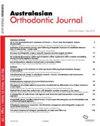Pulp chamber temperature changes during orthodontic bonding – an in vitro study
IF 0.9
4区 医学
Q4 DENTISTRY, ORAL SURGERY & MEDICINE
引用次数: 0
Abstract
Abstract Aim Using a thermal camera, the aim of the study was to determine pulp chamber temperature changes during orthodontic bonding produced as a result of variations in curing light sources, different curing distances and bracket types. Methods One hundred sixty maxillary premolar teeth were sectioned into two halves and embedded into acrylic moulds. Four curing light sources were used which further divided the overall sample into Halogen, light emitting diode (LED), powered LED, and high-power LED groups. Additional subgroups were created according to the applied curing distances (5 mm, 10 mm) and different bracket types (metallic or ceramic). A standardised bonding procedure was performed and pulp chamber temperature changes were evaluated using a thermal camera. Statistical analysis was performed using a three-way ANOVA. Results The Halogen light curing group revealed a significantly higher temperature rise in the pulp chamber compared to the other groups. A shorter curing distance produced increases in pulpal temperature. There was no significant effect as a result of the bracket type. Conclusions None of the curing light sources exceeded the critical value for pulp chamber temperature rise. The primary desirable outcome was the lowest temperature increase noted with the high-power LED unit. The secondary outcome related to the different brackets revealed no difference relative to pulp chamber temperature change. From a clinical perspective, high-power LED units could be safely used.正畸粘接过程中牙髓腔温度变化的体外研究
摘要目的利用热像仪研究正畸粘接过程中牙髓腔温度随固化光源、固化距离和托架类型的变化而发生的变化。方法将160颗上颌前磨牙切成两半,植入丙烯酸模内。采用四种固化光源,进一步将整体样品分为卤素、发光二极管(LED)、供电LED和大功率LED组。根据应用的固化距离(5毫米,10毫米)和不同的支架类型(金属或陶瓷)创建额外的子组。进行了标准化的粘合程序,并使用热像仪评估了牙髓腔的温度变化。采用三向方差分析进行统计分析。结果卤素光固化组牙髓腔温升明显高于其他组。固化距离越短,牙髓温度越高。由于支架类型,没有显著的影响。结论所有固化光源均未超过牙髓室温升临界值。主要的理想结果是高功率LED单元所注意到的最低温度升高。与不同托槽相关的次要结果显示,相对于牙髓室温度的变化没有差异。从临床角度来看,大功率LED单元可以安全使用。
本文章由计算机程序翻译,如有差异,请以英文原文为准。
求助全文
约1分钟内获得全文
求助全文
来源期刊

Australasian Orthodontic Journal
Dentistry-Orthodontics
CiteScore
0.80
自引率
25.00%
发文量
24
期刊介绍:
The Australasian Orthodontic Journal (AOJ) is the official scientific publication of the Australian Society of Orthodontists.
Previously titled the Australian Orthodontic Journal, the name of the publication was changed in 2017 to provide the region with additional representation because of a substantial increase in the number of submitted overseas'' manuscripts. The volume and issue numbers continue in sequence and only the ISSN numbers have been updated.
The AOJ publishes original research papers, clinical reports, book reviews, abstracts from other journals, and other material which is of interest to orthodontists and is in the interest of their continuing education. It is published twice a year in November and May.
The AOJ is indexed and abstracted by Science Citation Index Expanded (SciSearch) and Journal Citation Reports/Science Edition.
 求助内容:
求助内容: 应助结果提醒方式:
应助结果提醒方式:


